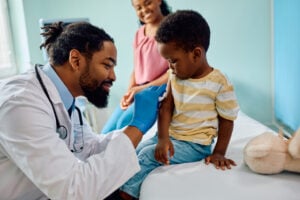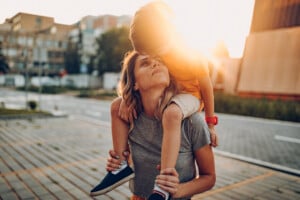It never fails. When you are with the kids, they’re little hellions on wheels. But when they’re with their dad, they toe the line. Why do they behave better with Dad?! This is a big question that probably touches a nerve with many moms.
Before I get into the answers, I want to clarify my use of “Mom” and “Dad” for this discussion. Whether you parent with your spouse, co-parent, step-parent, same-sex partner, or no partner, the following descriptions can show up in any family. Maybe you and your spouse take on roles opposite to what I describe, or you switch roles throughout the week. Perhaps you’re a solo parent who embodies bits and pieces of both roles, or you see this play out with other caregivers. Whatever your situation, know that the parenting relationship is constantly evolving. I use the terms “Mom” and “Dad” for coherency in addressing this question.
I also want to highlight the phrase “behave better” before digging in. The ingrained belief that a child’s behavior is good or bad limits our perspective on children. Psychologists and researchers (like Dr. Mona Delahooke) are reframing our view of behavior to understand it simply as communication. The challenging behavior we see in children is not malicious, manipulative, personal, or even intentional. Seeing any behavior as a child’s attempt to communicate helps us respond in a supportive (rather than punitive or defensive) way.
Now that we see this question has so much embedded into it, let’s get some answers.
Reasons Kids Behave Better With One Parent Over the Other
It’s true that adults feel better when kids behave a certain way. Parents desire to experience children who cooperate, don’t put up big resistance, and show more laughter than tears. Everyone wants to feel good being together. So, why do kids seem to show more cooperation, compliance, and cheerfulness with Dad than with Mom? I mentioned that behavior is communication. Communication depends on our perception. Children perceive differences and then respond (behave) differently according to those perceptions. Here are some reasons kids may behave better with one parent over the other:
1. More Time
If your family is similar to mine, Mom spends more time with the kids than Dad. Even moms with other jobs tend to carry out most caregiving tasks, whether it’s getting kids ready in the morning, attending activities, or managing bedtime routines. The amount of contact time children have with different adults can influence how we experience their behavior.
Statistically speaking, if I spend six hours each weekday with my kids and my husband spends two hours each weekday, I’m more likely to see challenging behavior. Sometimes it’s that simple — the person with the kids the most witnesses the most.
Another outcome of this is each parent’s emotional bandwidth for healthy and supportive interactions.3 If a parent is frustrated, tired, or emotionally drained, it can make it difficult to parent positively or be constructive with their children, which influences the child’s behavior.3 By the time we’re getting the kids ready for bed, I have spent most of my patience, empathy, and compassion. There’s a good chance my emotional energy will elicit challenging behaviors from my kids (or, at the very least, their normal behaviors feel more difficult because I feel spent). Meanwhile, my husband could have more patience and playfulness in his bucket, which elicits easy and joyful responses from the kids. Again, these are only possible scenarios. They can easily be the complete reverse.
One final effect of contact time is saturation. When one parent spends more time with the kids, the other parent becomes a novelty in the child’s eyes. The anticipation and excitement create an environment where the child becomes more engaged and enthusiastic with the parent who spends less time with the child. As Jamie Glowacki asserts in her book, “Oh Crap! Potty Training,” “Everyone knows Dad is a little magic.”
2. Parenting Style
A significant factor in how kids behave with each parent is parenting style. Kids are intelligent, intuitive, and adaptive. If parents parent differently, children behave differently.4 This is encouraging because if you want your child to behave differently, you can create the change by parenting differently.
For example, let’s say Mom has an authoritative style: she holds firm boundaries and is comfortable navigating the pushback that comes with it.4 Let’s say Dad typically has an authoritarian style: he is strict, allows no room for negotiation, and does not tolerate resistance of any kind.4 Children in this environment will learn (quickly) that Mom can handle some whining, fussing, or even occasional backtalk while Dad does not allow it, ever. The children may respond with more resistance to Mom’s boundaries and total compliance (misinterpreted as “good” behavior) with Dad’s boundaries.
Alternatively, maybe Mom has a permissive style: she puts up a strong front but always caves in the end. Maybe Dad has a conscious parenting style: he holds firm boundaries and collaborates with the kids to stick to them. Mom will get the whining, moaning, and complaining (because it works eventually), while Dad gets questions, suggestions, and creative solutions.
The truth is that all parents can exhibit all styles of parenting. Noticing which style you’re using and how your children respond will tell you a lot about the dynamics of your relationship at that moment.
3. Brain Development
Children’s brain development is another direct link to their behavior. Humans use mirror neurons from infancy into adulthood to observe and learn from their social interactions.1 When an adult is smiling, laughing, and generally relaxed, a child typically responds with the same demeanor. When an adult is tense, averting eye contact, and speaking harshly, a child observing those interactions will become tense, uptight, or withdrawn in response.
How does this factor into a child’s behavior with their parents? Look at the signals from Mom or Dad’s body language and facial expressions. If Dad is energized and enthusiastic with the kids, they respond with matched energy and enthusiasm. If Mom is frustrated and irritated around the kids, they are more likely to react with impatience and irritation. Again, these traits and corresponding behaviors can apply to any adult and child interaction. One parent, or the other, may have a personality that tends toward a lighthearted, playful mood or a more serious or guarded demeanor. There is no right or wrong, good or bad person here. The awareness of your child inherently imitating adult expressions and behaviors is most important.
4. Secure Attachment
A critical concept called secure attachment is a final factor that can make it seem like kids behave better with Dad. In their book “The Power of Showing Up,” Daniel Siegel and Tina Payne Bryson describe parents as “safe harbors” for their children, creating a secure attachment for the child.2 This means the parent can remain calm, present, and attuned when the child is in an emotional storm. Those emotional storms are usually what erupt as big behaviors. When a child experiences any parent’s avoidance, withdrawal, punishment, or overreaction, that child builds emotional defenses and stops showing those big feelings. When a child is welcomed with empathy, compassion, and security, they learn that expressing turbulent emotions is not only tolerated but accepted.
From the child’s point of view, it’s a simple question: “Is it safe to show my feelings?” They know which parent provides the safe harbor, and that’s the parent who will witness the toughest moments. So, while it may be hard to be the safe harbor, know that if you see challenging behavior from your child, it’s because they are know they are safe with you and can express themselves fully without fear. I know . . . it’s a backward kind of compliment, but it’s a compliment nonetheless.
The Bottom Line
If you agree that your child does “behave better” with Dad, please do not take it personally. Children aren’t putting their parents against each other. They aren’t taking sides or playing favorites. Children are beautifully complex beings with real needs, raw emotions, and developmentally immature brains, and they do their best to thrive in every moment. Don’t get offended or disappointed when you perceive that your child behaves differently with another caregiver. Get curious: What is my child communicating? What are they responding to? What is going on underneath those behaviors? If you are taking the brunt of the big behaviors, be grateful your child feels safe to do so. You’re giving your child exactly what they need.






























